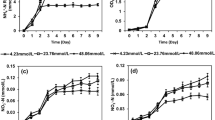Abstract
The freshwater colorless sulfur bacterium Beggiatoa “leptomitiformis”D-402 was shown to be capable of lithoautotrophic growth in a batch culture under microoxic conditions at O2concentrations in the medium of no higher than 0.5 mg/l. The cell yield was maximum at a dissolved oxygen concentration of 0.15 mg/l. A high activity level of key enzymes of the Calvin cycle and of enzymes involved in dissimilatory oxidation of thiosulfate was recorded in the cells. The high rate of CO2assimilation (112–139 nmol/(min mg protein)) and the cell yield (12 mg dry cells/mmol thiosulfate oxidized), 91–92% of which was accounted for by CO2carbon, were close to those typical of autotrophic bacteria. Thiosulfate was oxidized almost completely to sulfate, and the fraction of intracellular sulfur in the final products did not exceed 0.2–1.7% of the thiosulfate sulfur. The cell membrane fraction contained cytochromes (b + o) and two cytochromes cwith M rof 23 and 26 kDa; the soluble fraction contained cytochrome cwith M rof 12 kDa.
Similar content being viewed by others
References
Nelson, D.C. and Jannasch, H.W., Chemoautotrophic Growth of a Marine Beggiatoa in Sulfide-Gradient Cultures, Arch. Microbiol., 1983, vol. 136, pp. 262–269.
Nelson, D.C., Jörgensen, B.B., and Revsbach, N.P., Growth Pattern and Yield of Chemoautotrophic Beggiatoa sp. in Oxygen-Sulfide Microgradients, Appl. Environ. Microbiol., 1986, vol. 52, pp. 225–233.
Pringsheim, E.G., Die Mixotrophie von Beggiatoa, Arch. Mikrobiol., 1967, vol. 59, pp. 247–254.
Nelson, D.C. and Castenhoz, R.W., Use of Reduced Sulfur Compounds by Beggiatoa sp., J. Bacteriol., 1981, vol. 147, pp. 140–154.
Güde, H., Strohl, W.R., and Larkin, J.M., Mixotrophic and Heterotrophic Growth of Beggiatoa alba in Continuous Culture, Arch. Microbiol., 1981, vol. 129, pp. 357–360.
Strohl, W.R., Cannon, G.C., Shively, J.M., Güde, H., Hook, L.A., Lane, C.M., and Larkin, J.M., Heterotrophic Carbon Metabolism by Beggiatoa alba, J. Bacteriol., 1981, vol. 148, pp. 572–583.
Grabovich, M.Yu., Dubinina, G.A., Lebedeva, V.Yu., and Churikova, V.V., Mixotrophic and Lithoheterotrophic Growth of the Freshwater Filamentous Sulfur Bacterium Beggiatoa leptomitiformis D-402, Mikrobiologiya, 1998, vol. 67, no. 4, pp. 383–388.
Pfennig, N. and Lippert, K.D., Uber das Vitamin B12-Bedurfnis phototropher Schwefelbakterien, Arch. Mikrobiol., 1966, vol. 55, pp. 245–256.
Rabinovich, V.A. and Sherman, E.E., Modification of the Winkler Method to Determine Dissolved Oxygen in Small Volumes of Liquid, Rol' mikroorganizmov v obrazovanii Fe-Mn ozernykh rud (Role of Microorganisms in the Formation of Fe-Mn Concretions in Lakes), Moscow: Nauka, 1964, pp. 81–87.
Rusinova, N.G., Romanova, A.K., Litovchenko, G.N., and Doman, N.G., Peculiarities of the Carbon Dioxide Fixation Process in the Thionic Bacterium 58R, Mikrobiologiya, 1971, vol. 40, no. 5, pp. 765–771.
Kelly, D.P., Biochemistry of Chemolithoautotrophic Oxidation of Inorganic Sulfur, Philos. Trans. R. Soc. London, 1982, vol. 298, pp. 499–528.
Romanova, A.K., Biokhimicheskie metody izucheniya avtotrofii u mikroorganizmov (Biochemical Methods for Studying Autotrophy in Microorganisms), Moscow, 1980, p. 230.
Petushkova, Yu.P. and Ivanovskii, R.N., Enzymes Involved in Thiosulfate Metabolism in Thiocapsa roseopersicina during Growth in Various Conditions, Mikrobiologiya, 1976, vol. 45, no. 4, pp. 960–965.
Grabovich, M.Yu., Muntyan, M.S., Lebedeva, V.Yu., Ustiyan, V.S., and Dubinina, G.A., Lithoheterotrophic Growth and Electron Transfer Chain Components of the Filamentous Gliding Bacterium Leucothrix mucor DSM 2157 during Oxidation of Sulfur Compounds, FEMS Microbiol. Lett., 1999, vol. 178, pp. 155–161.
Jörgensen, B.B. and Revsbach, N.P., Colorless Sulfur Bacteria Beggiatoa spp. and Thiovulum spp. in O2 and H2S Microgradients, Appl. Environ. Microbiol., 1983, vol. 45, pp. 1261–1270.
Kuenen, J.G. and Beudeker, R.F., Microbiology of Thiobacilli and Other Sulfur-Oxidizing Autotrophs, Mixotrophs, and Heterotrophs, Philos. Trans. R. Soc. London, 1982, vol. 298, pp. 473–497.
Hagen, K.D. and Nelson, D.C., Organic Carbon Utilization by Obligately and Facultatively Autotrophic Beggiatoa Strains in Homogeneous and Gradient Cultures, Appl. Environ. Microbiol., 1996, vol. 62, pp. 947–953.
Hagen, K.D. and Nelson, D.C., Use of Reduced Sulfur Compounds by Beggiatoa spp.: Enzymology and Physiology of Marine and Freshwater Strains in Homogeneous and Gradient Cultures, Appl. Environ. Microbiol., 1997, vol. 63, pp. 3957–3964.
Prince, R.C., Stokley, K.E., Haith, C.E., and Jannasch, H.W., The Cytochromes of Marine Beggiatoa, Arch. Microbiol., 1988, vol. 150, pp. 193–196.
Schmidt, T.M. and DiSpirito, A.A., Spectral Characterization of c-Type Cytochromes Purified from Beggiatoa alba, Arch. Microbiol., 1990, vol. 154, pp. 453–458.
Author information
Authors and Affiliations
Rights and permissions
About this article
Cite this article
Patritskaya, V.Y., Grabovich, M.Y., Muntyan, M.S. et al. Lithoautotrophic Growth of the Freshwater Colorless Sulfur Bacterium Beggiatoa “leptomitiformis”D-402. Microbiology 70, 145–150 (2001). https://doi.org/10.1023/A:1010469211447
Issue Date:
DOI: https://doi.org/10.1023/A:1010469211447




